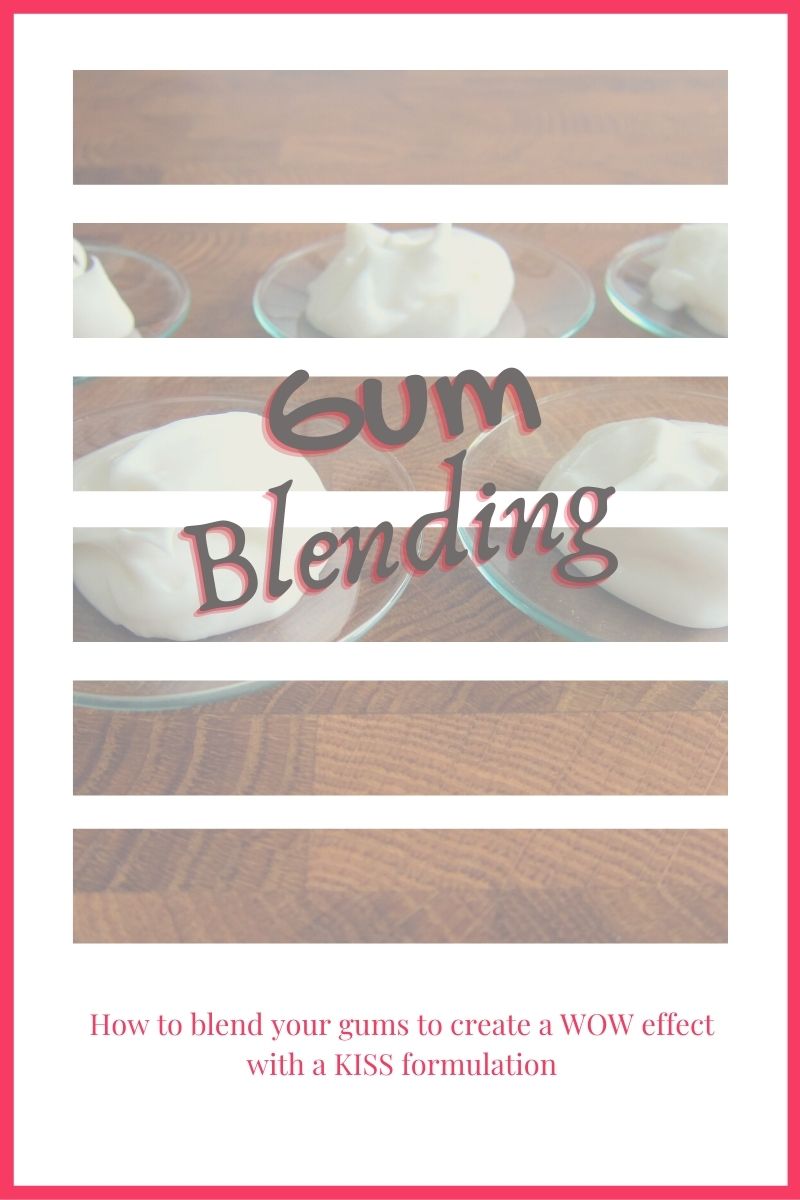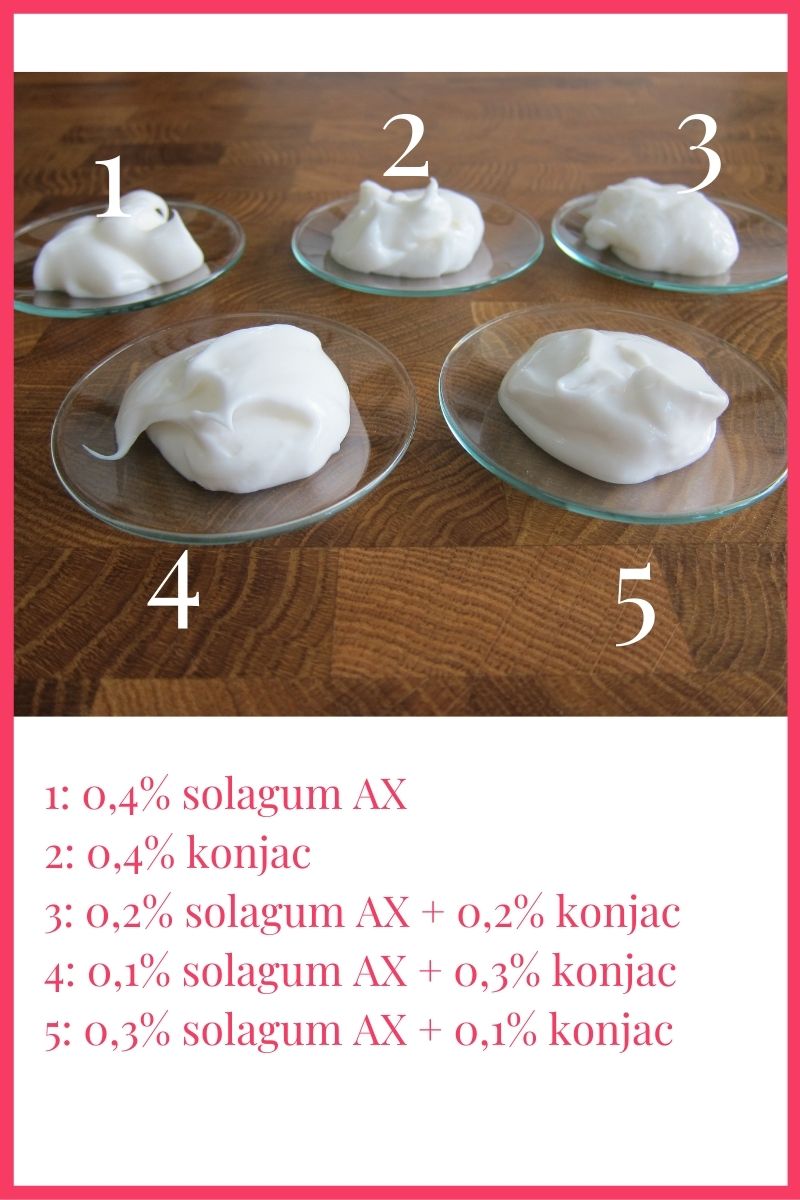
Donnerstag, 29. April 2021
The magic of gum blending
Natural gums are one of the most fascinating cosmetic ingredients and I have dedicated several posts in the past to them:
What you need to know about natural gums (part I)
What you need to know about natural gums (part II): Gum blending
How to improve the stability of your gel scrubs
Xanthan gum: one gum, 1001 applications
Xanthan meets: Gum synergy, get the best out of your natural gums-I
Xanthan meets: Gum synergy, get the best out of your natural gums-II
Even more fascinating than natural gums is when you blend gums together. Hier the magic happens and you can boost the stabilizing properties of each gum, improve the texture and skin feel or even change the structure completely.
For this experiment, we have used our Solagum AX which is a commecial blend of acacia and xanthan gum and have added konjac gum at various proportions and studied the effect.
None of these gums create a "gel" structure but the magic happens when xanthan and konjac are blended and a 3-dimensional gel structure is made from 2 gums that do not make any gel on their own.
We have made a very KISS and basic formulation and just varied the gum and the difference was quite obvious even without using any viscosimeter or microscope.
This is our basic formulation
| Phase A | |
| Distilled or deionized water | to 100,0% |
| Na-PCA | 2,0% |
| Natural chelator PA-3 | 0,1% |
| Aquaxyl | 2,0% |
| L-Arginin | 0,2% |
| Phase B | |
| Gum | 0,4% |
| Phase C | |
| Polyaquol 2W | 5,0% |
| Marula oil | 20,0% |
| Tocopherol | 0,3% |
| Phase D | |
| Eucalyptus oil | 0,3% |
| Litsea cubeba oil | 0,7% |
| Versatile preservative TBG | 1,0% |
| Lactic acid | to adjust the pH |
About the formulation:
As you have seen in our previous videos and blog posts, since we are using a preservative that reduced the pH, we add arginine at the beginning to increase the pH slightly. The pH of the emulsion before adding the preservative is around 7,50 and by adding the preservative it is reduced to slightly above 6. Then by adding just 1-3 drops of 80% lactic acid (for 100 gr emulsion) the pH is easily adjusted in the range that we want.
If we don't increase the pH at the beginning, the pH of the emulsion will drop to lower than 5 after adding the preservative. This pH is not suitable for using this preservative and it is much more difficult to increase the pH of the finished emulsion by adding arginin than to reduce the pH by adding lactic or citric acid.
The gums we used:
1- 0,4% solagum AX
2- 0,4% Konjac gum
3- 0,2% Konjac + 0,2% Solagum AX
4- 0,3% Konjac + 0,1% solagum AX
5- 0,1% Konjac + 0,3% Solagum AX
Procedure:
1- Blend all ingredients in phase A @RT
2- Disperse and hydrate the gum @RT
3- When the gum is fully hydrated heat phase A and B in a water bath between 80-85 oC
4- Outside of the bath add the oil phase to the water phase and homogenize
5- Start cooling down and stirring
6- As the temperature reaches <35 oC add the essential oils
7- Prepare a 10% dilution and measure the pH. It was around 7,5 in our case and that is suitable for adding the preservative we are using
8- Add the preservative. Make another 10% dilution and remeasure the pH. It should be around 6,3-6,50.
9- Dropwise add lactic acid (40% or 80%) to reduce the pH between 5,3-5,5
10- Take your stability and micro kit samples and fill the rest in suitable containers.
11- Observe the viscosity, texture, skin feel after at least 24 hours. Keep an eye on the samples and observe them after 1 and 2 weeks and select the one you like the most
The results
These are our samples at RT after 3 weeks. The sample with pure konjac is the least appealing one. Optically it is not attractive, the texture is not smooth and the skin feel is sticky. It has a much higher viscosity than the sample with solagum AX.
The blends of solagum AX and konjac are all nice and have a higher viscosity than the sample with solagum AX alone. Our team has unitedly selected the sample with 0,1% konjac+ 0,3% Solagum AX as the favourite. The texture is very nice and smooth and the skin feel is more like a light cream gel than a cream with 20% oil phase.
I hope you feel inspired to experiment with the gums you have in your stash.
Watch this short video when I show you the samples and demonstrate the gel-binding properties of the gum blend.


